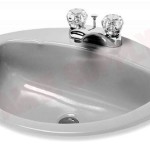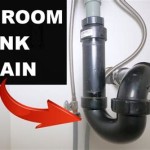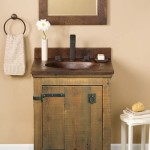Parts of the Bathroom Sink Drain: A Comprehensive Guide
The bathroom sink drain is a seemingly simple fixture, yet it comprises several interconnected parts that work together to effectively remove wastewater and prevent sewer gases from entering the home. Understanding the individual components and their respective functions is crucial for proper maintenance, troubleshooting, and repair of plumbing issues.
This article provides a detailed overview of the various parts of a typical bathroom sink drain, explaining their roles within the system. Attention will be given to the common materials used in their construction, as well as potential problems that may arise.
The Sink Stopper
The sink stopper, also known as the drain stopper or plug, is the most visible part of the drain assembly. Its primary function is to block the drain opening, allowing the sink to hold water. Stoppers come in various designs, each employing a different mechanism for opening and closing the drain.
A common type is the lift-rod stopper, which is operated by a vertical rod extending from the sink faucet or nearby. Lifting the rod raises the stopper, allowing water to drain; pushing the rod down seals the drain. The lift-rod stopper typically consists of a stopper body, often made of brass or plastic, and a connecting rod that links it to the lift rod mechanism.
Another frequently encountered stopper is the pop-up stopper. This type has a button or knob on the faucet that, when pressed, causes the stopper to pop up and allow water to drain. When pressed again, the stopper seals the drain. Pop-up stoppers often feature intricate mechanisms involving pivot rods and springs. These parts can be susceptible to wear and tear, contributing to drain clogging and stopper malfunction.
A third type of stopper is the push-and-seal stopper, which operates by simply pressing down on the stopper itself to seal the drain and pressing again to release it. These stoppers have a simple construction, often made of silicone or rubber, and are relatively easy to install and maintain.
Regardless of the type, stoppers are essential for holding water in the sink for various purposes, such as washing hands, shaving, or cleaning. A properly functioning stopper ensures the efficient use of water and prevents unnecessary waste.
The Drain Flange
The drain flange is the part that sits directly inside the sink basin, encircling the drain opening. It provides a secure and watertight connection between the sink and the drainpipe. The flange is typically made of metal, such as brass or stainless steel, or durable plastic, chosen for its resistance to corrosion and wear. The material of the flange should be compatible with the sink material to prevent galvanic corrosion.
The drain flange features a lip that rests on the surface of the sink, forming a seal. Underneath the sink, the flange is threaded to connect to the tailpiece, which is the next component in the drain assembly. A rubber or silicone washer is often placed between the flange and the sink to create a watertight seal and prevent leaks.
Over time, the drain flange can become corroded or damaged, leading to leaks. Mineral buildup and hard water deposits can also accumulate on the flange, hindering its proper functioning and potentially causing blockages. Regular cleaning and inspection of the drain flange are essential for maintaining its integrity and preventing costly repairs.
The flange is typically secured to the sink with plumber's putty or silicone caulk, creating a waterproof barrier that prevents water from seeping between the flange and the sink surface. Proper installation of the drain flange is crucial to prevent leaks and ensure the overall functionality of the drain assembly.
Some drain flanges also incorporate a grid or strainer to prevent hair and other debris from entering the drainpipe. This strainer helps to minimize clogs and maintain proper drainage.
The Tailpiece
The tailpiece is a cylindrical pipe that extends vertically downwards from the drain flange underneath the sink. It connects the drain flange to the P-trap, which is the next crucial component in the drain assembly. The tailpiece is typically made of metal, such as brass or PVC (polyvinyl chloride) plastic, chosen for its durability and resistance to corrosion.
The length of the tailpiece can vary depending on the height of the sink and the location of the P-trap. Adjustable tailpieces are available, allowing for customization to fit specific plumbing configurations. This adjustability is especially helpful when replacing a sink or modifying the plumbing system.
The tailpiece is connected to the drain flange using a threaded connection and a slip nut. A rubber or plastic washer is placed between the tailpiece and the flange to create a watertight seal. Proper tightening of the slip nut is essential to prevent leaks. Over-tightening, however, can damage the connection and lead to cracking or stripping of the threads.
The tailpiece is a critical component in directing wastewater away from the sink and into the drainage system. Any cracks, leaks, or blockages in the tailpiece can disrupt the flow of water and potentially cause water damage.
Often, the tailpiece will have a small hole for the pivot rod of the pop-up drain stopper. This allows the rod to move up and down, controlling the stopper's position within the drain flange.
The P-Trap
The P-trap is a curved pipe located beneath the sink that is designed to trap water and prevent sewer gases from entering the home. Its distinctive P-shape creates a water barrier that effectively seals off the drainpipe from the sewer system.
The P-trap is typically made of PVC or metal, such as chrome-plated brass. The material choice often depends on aesthetic considerations and the overall design of the bathroom. While PVC is more resistant to corrosion, metal traps offer a more polished and visually appealing look.
The P-trap consists of three main sections: the inlet pipe, the U-bend, and the outlet pipe. Wastewater flows from the tailpiece into the inlet pipe, then travels through the U-bend, where a small amount of water remains trapped. This trapped water forms the seal that prevents sewer gases from rising up through the drainpipe and into the bathroom.
The outlet pipe connects the P-trap to the drainpipe in the wall, allowing wastewater to flow into the main sewer line. The P-trap is typically connected to the tailpiece and the drainpipe using slip nuts and washers, creating watertight seals.
The P-trap is a crucial component in maintaining a sanitary and safe environment in the bathroom. Without a properly functioning P-trap, noxious and potentially harmful sewer gases could leak into the home, posing a health risk. Regular cleaning of the P-trap is recommended to remove accumulated debris and prevent blockages. Many P-traps have a cleanout plug at the bottom of the U-bend for easy access and maintenance.
The Drainpipe
The drainpipe is the pipe that carries wastewater from the P-trap to the main sewer line. It is typically located inside the wall behind the sink and is generally made of PVC or copper. The diameter of the drainpipe is usually standardized to ensure proper flow and prevent backups.
The drainpipe is connected to the P-trap using a slip nut and washer. The connection should be tightened securely to prevent leaks. The drainpipe slopes downwards slightly to facilitate the flow of wastewater towards the sewer line. This slope is critical for preventing standing water and clogs.
The drainpipe is often concealed within the wall, making it less accessible for maintenance and repairs. However, leaks or blockages in the drainpipe can cause significant water damage and require professional plumbing services.
In some cases, the drainpipe may connect to a vent pipe, which allows air to enter the drain system and prevent siphoning of the water in the P-trap. The vent pipe ensures that the P-trap maintains its water seal and effectively blocks sewer gases.
The drain pipe’s size is important. Too small and the drain will be too slow. Too big, and it will not drain properly. Consult local plumbing codes for the proper diameter. Over time, corrosion, tree root intrusion (if the line goes underground), or shifting ground can damage the drainpipe, necessitating repair or replacement.
By understanding the function of each part of the bathroom sink drain system, homeowners can better troubleshoot minor plumbing problems and maintain a properly functioning drainage system. Recognizing the signs of potential issues, such as slow drainage or foul odors, can help prevent more significant and costly repairs in the future.
Parts Of A Sink The Home Depot

Parts Of A Sink The Home Depot

20 Parts Of Bathroom Sink Drain

Bathroom Sink Plumbing

Parts Of A Sink The Home Depot

Parts Of A Sink Complete Guide For Diy Plumbing
How To Install Bathroom Sink Drain Queen Bee Of Honey Dos

Parts Of A Sink The Ultimate Guide

Sink Drain Plumbing

Parts Of A Sink The Ultimate Guide
Related Posts







